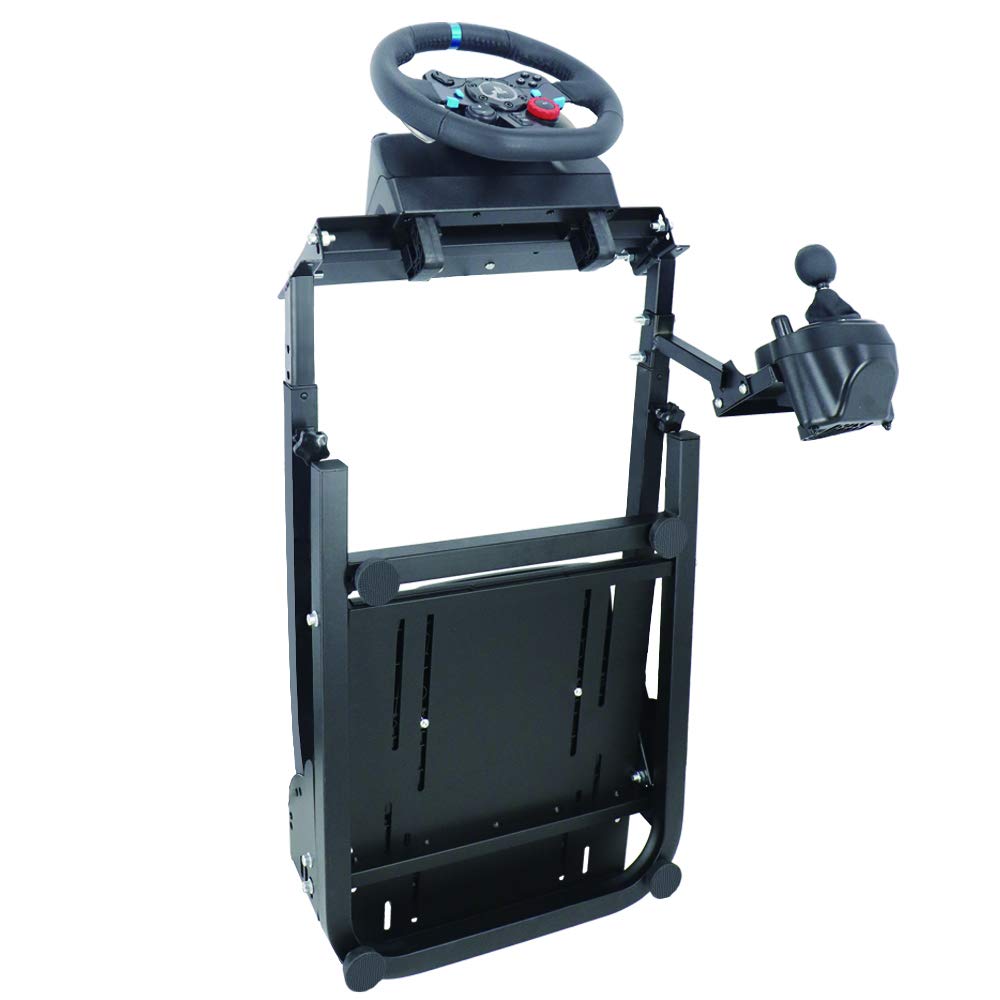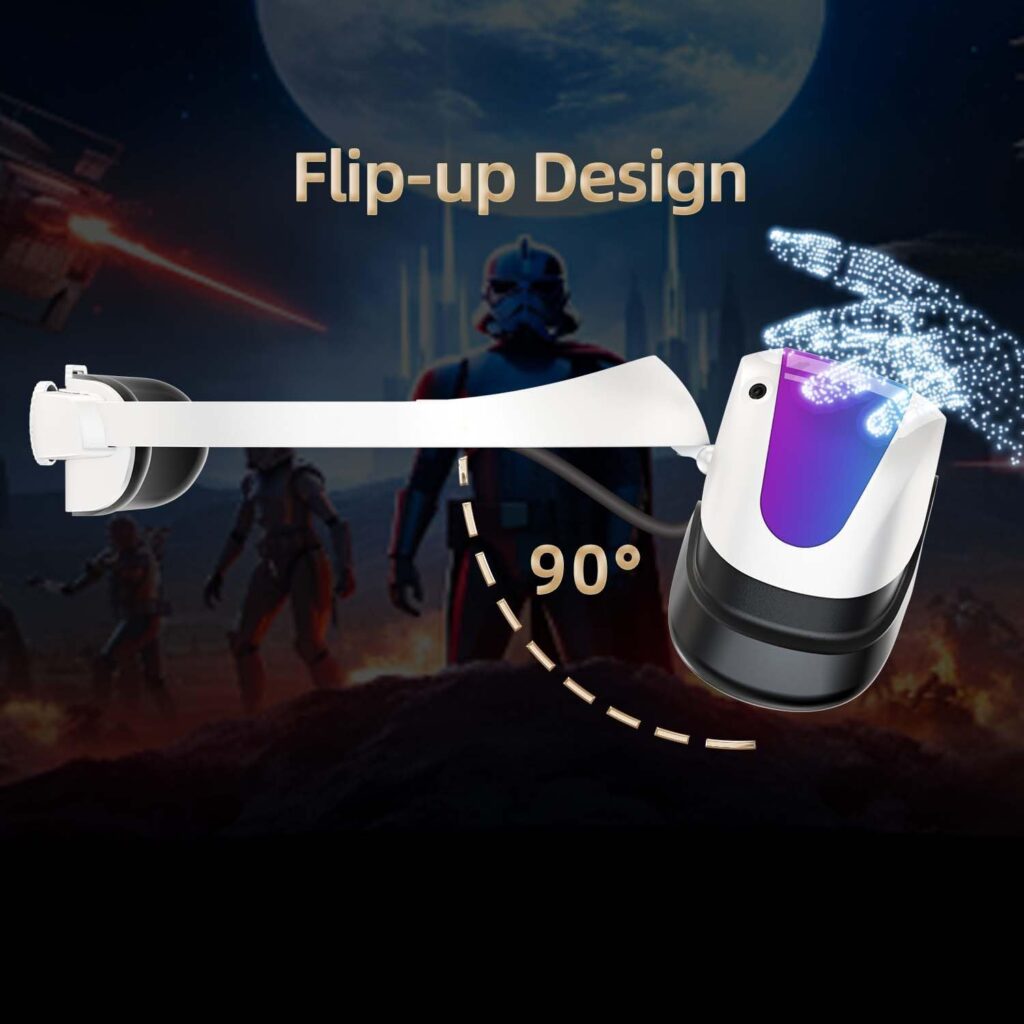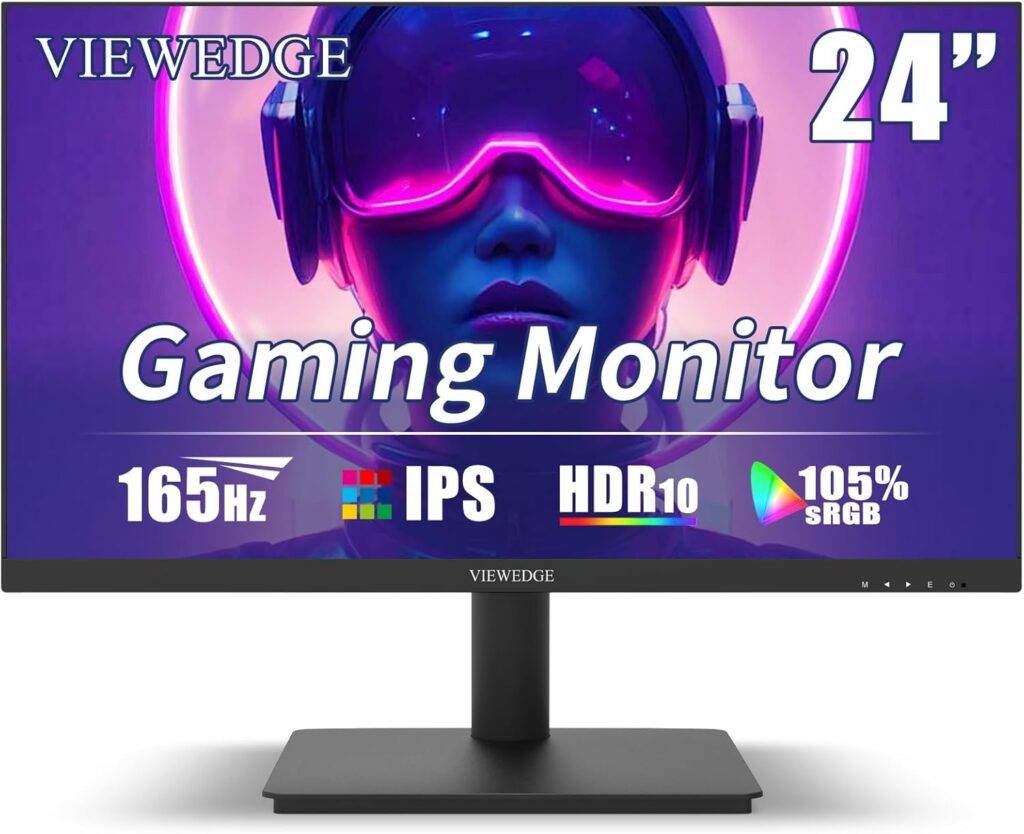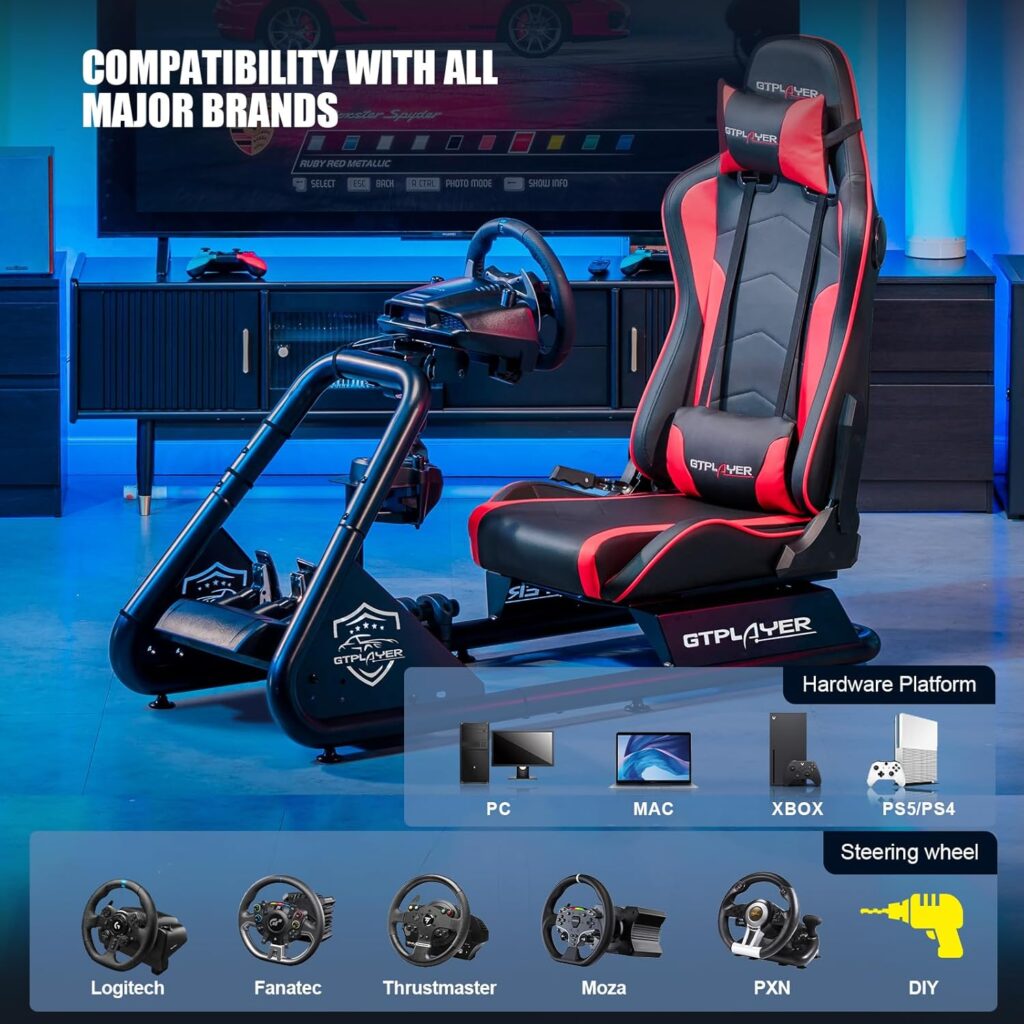Have you ever wondered what it feels like to race on a virtual track, pushing your limits and experiencing the thrill of high-speed competition? Well, the world of sim racing might just be the answer you're looking for.
Whether you're a complete beginner or someone with a little racing experience, 'Your First Lap: A Beginner's Guide to Sim Racing' is here to help you navigate the exciting world of virtual racing. From choosing the right gear to mastering the basics and exploring the world of competitive sim racing, this guide has everything you need to kickstart your journey.
But before we dive into the exhilarating world of sim racing, let's take a closer look at what it truly means to be a sim racer.
Key Takeaways
- Choosing the right sim racing wheelbase is crucial for a realistic experience.
- Consistent practice is essential for improving skills in different racing scenarios.
- Invest in a high-quality steering wheel and pedal set for a more immersive experience.
- Join online communities and participate in competitive sim racing events for an adrenaline-pumping experience.
Sim Racing Equipment: Choosing the Right Gear
When it comes to choosing the right gear for sim racing, selecting the perfect sim racing wheelbase is a crucial first step. A wheelbase refers to the central part of a sim racing setup that includes the steering wheel and force feedback system. There are three main types of wheelbases: direct drive, gear-driven, and belt-driven.
Direct drive wheels offer the most realistic and immersive experience, delivering unparalleled force feedback and precision. Gear-driven wheelbases are a popular choice among beginners due to their affordability and decent force feedback capabilities. Belt-driven wheelbases strike a balance between the two, offering smooth and responsive force feedback at a more reasonable price point.
Another important component to consider when building your sim racing equipment is the set of pedals. Sim racing pedals come in various types, such as potentiometer, hall effect, and load cell. Load cell pedals are highly recommended for their realistic feel and enhanced precision. They measure the pressure applied to the pedals, making them more accurate and responsive compared to potentiometer or hall effect sensors.
Additionally, look for pedals that can handle your weight limits and offer easy attachment to your sim racing rig.
Mastering the Basics: Getting Started With Virtual Racing
Now that you have chosen the perfect sim racing wheelbase and pedals for your setup, it's time to dive into mastering the basics of virtual racing. Whether you're a seasoned gamer or completely new to racing simulators, getting started in the world of sim racing can be both exciting and challenging. To ensure you have the best sim racing setup and can be competitive in online races, it's important to understand the fundamentals.
One key aspect of virtual racing is the detailed force feedback provided by sim racing wheels. This feature allows you to feel the road surface, tire grip, and even the slightest changes in the car's behavior. It's crucial to spend time adjusting the force feedback settings to your preference, as this will greatly enhance your overall driving experience.
For serious sim racers looking to compete online, it's essential to practice consistently. Mastering the basics requires putting in the hours behind the wheel, honing your skills in different racing scenarios. Whether it's learning to take the perfect racing line, braking at the right moment, or executing clean overtakes, practice is the key to improvement.
Furthermore, familiarize yourself with the racing rules and etiquette of online competitions. Respect other drivers, avoid reckless behavior, and always strive for fair racing. This won't only make the online racing experience more enjoyable for everyone involved but will also help you gain a positive reputation within the sim racing community.
Enhancing Your Experience: Sim Racing Peripherals
To enhance your sim racing experience, consider adding sim racing peripherals that will further immerse you in the virtual world of racing. One of the most important peripherals to invest in is a high-quality steering wheel and pedal set. While a controller or keyboard can work, a dedicated racing wheel and pedals will provide a more immersive and realistic experience.
When it comes to sim racing peripherals, there are various options to choose from. Steering wheels come in different sizes, shapes, and with varying degrees of force feedback. Wheelbases, such as direct drive, offer even more realistic force measurement and precision. Pedals can also be customized, with options like load cell technology that provides accurate and realistic brake pedal feel.
Setting up your sim racing equipment involves mounting the peripherals securely and configuring them for optimal performance. It's important to consider your budget and desired level of immersion when choosing sim racing peripherals. Researching and seeking guidance from experienced sim racers can help you navigate the options available and make informed decisions.
Setting Up Your Sim Racing Equipment
Ensure a comfortable and ergonomic setup by positioning your racing wheel and pedals correctly. The proper placement of your equipment is crucial for an enjoyable sim racing experience. By calibrating and customizing the settings of your racing wheel and pedals, you can tailor them to match your driving preferences.
To help you set up your sim racing equipment, refer to the table below:
| Equipment Placement | Recommendations |
|---|---|
| Racing Wheel | Mount it securely to a stable and sturdy sim rig or cockpit. |
| Pedals | Position them at a comfortable distance and angle. |
| Seating Position and Angle | Adjust it to maximize comfort and control. |
In addition to the racing wheel and pedals, you may also consider adding peripherals such as shifters and handbrakes to enhance your sim racing experience. These accessories can provide a more immersive feel and simulate the controls of a real racing car.
As you get started with sim racing, it's important to choose the right racing wheel and pedals for your needs. The market offers a variety of options, ranging from entry-level to high-end setups. Many racing drivers prefer direct drive wheels for their superior force feedback and responsiveness. However, there are also excellent options at more affordable price points.
Exploring the World of Competitive Sim Racing
Delve into the exciting realm of competitive sim racing and discover a world where virtual drivers compete for glory and adrenaline-pumping victories. As you start your journey into the world of sim racing, there are a few key things to keep in mind. Here are some essential aspects to consider:
- Getting Started in Sim Racing: To embark on your sim racing adventure, you'll need to invest in the right equipment. This includes a racing setup comprising of a steering wheel, pedals, and a racing seat.
- Types of Sim Racing: There are various types of sim racing, each offering a unique experience. From competitive online racing to immersive sim racing, you can choose the type that suits your preferences and skill level.
- Sim Racing Setups: Sim racing setups can range from basic to elaborate, depending on your budget and dedication. You can opt for a simple desk setup or go all out with a dedicated racing cockpit.
- Hardware and Software: To enjoy a realistic sim racing experience, you'll need hardware and software that can handle the demands of modern sim racing games. This includes a powerful gaming PC or console, as well as compatible racing simulation software.
As you explore the world of competitive sim racing, remember to practice, hone your skills, and most importantly, have fun. The competitive sim racing community is filled with passionate individuals, and with dedication and perseverance, you too can become a force to be reckoned with on the virtual racetrack.
Frequently Asked Questions
What Is the Basic Setup for Sim Racing?
To set up your sim racing experience, start by choosing a steering wheel that suits your preferences. Consider pedal configurations for realistic control.
Next, select a monitor that immerses you in the action. Create a comfortable seating position to avoid discomfort during long races.
Adjust force feedback settings to find the perfect balance. Optimize graphics settings for smooth performance.
Learn about different racing disciplines, track layouts, and racing lines. Master braking techniques for improved lap times.
Lastly, explore virtual racing communities for added excitement and competition.
What Game Should I Start Sim Racing?
To start sim racing, the best game for you depends on your preferences. Consider the realism you desire and the racing disciplines you're interested in.
Popular sim racing communities offer a variety of games catering to different skill levels. Whether you choose console or PC, it's important to invest in the right racing wheel for an immersive experience.
Simulators play a crucial role in professional racing, and participating in championships and tournaments can help improve your skills.
Do You Need a Rig for Sim Racing?
Yes, you can definitely enjoy sim racing without a rig. While a sim rig offers a more immersive experience, you can start with basic equipment like a game controller and a console or PC.
DIY sim racing setups are also popular and can be built on a budget. Sim racing provides numerous benefits, such as improving racing skills and offering a safe environment for practice.
There are also vibrant sim racing communities, software options, and accessories available for different platforms.
Can Sim Racing Get You Into Real Racing?
Sim racing can definitely pave the way to real racing. It offers numerous benefits, serving as a training tool and allowing you to develop skills like vehicle handling and racecraft.
Transitioning from sim racing to real racing involves understanding the differences between the two and utilizing techniques that translate well.
Sim racing communities also play a significant role, providing exposure and opportunities to connect with real racing teams.
With sim racing as a stepping stone, you can pursue a professional racing career and improve real racing skills along the way.
Conclusion
Congratulations! You have now reached the finish line of your sim racing journey.
Armed with the knowledge from 'Your First Lap: A Beginner's Guide to Sim Racing,' you're ready to conquer virtual tracks like a pro.
Remember, choosing the right gear, mastering the basics, and enhancing your experience with peripherals are all essential steps to becoming a successful sim racer.
So, buckle up, put your pedal to the metal, and enjoy the exhilarating world of competitive sim racing.
Good luck and happy racing!




